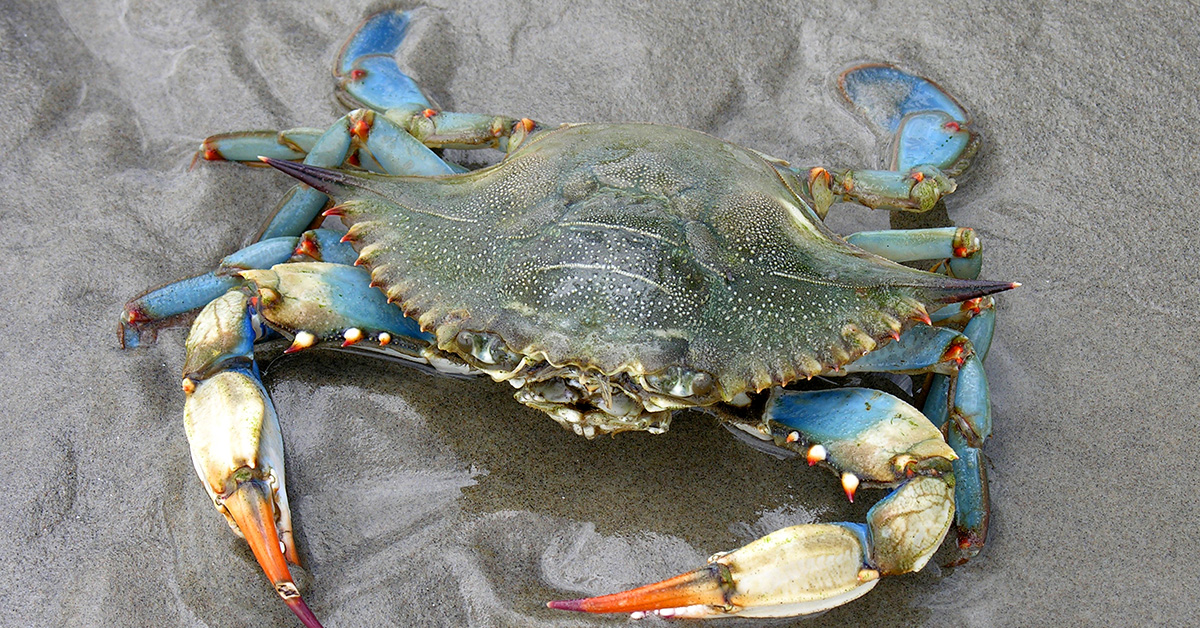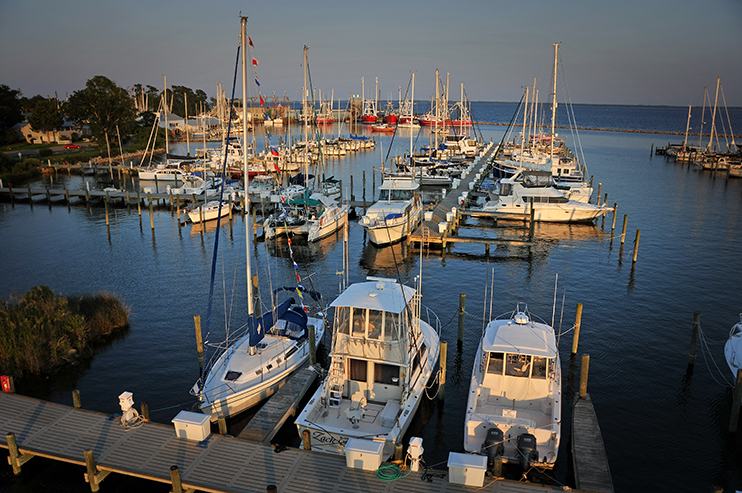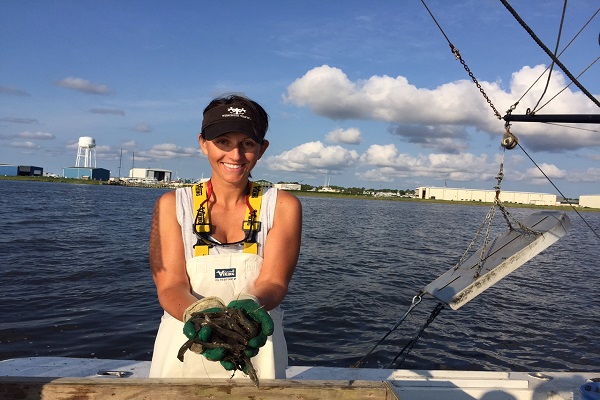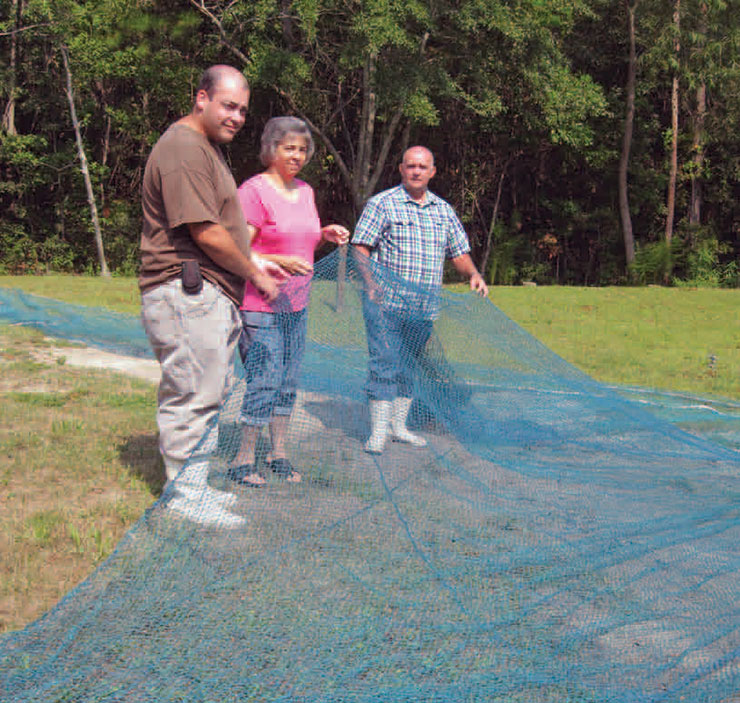SEA SCIENCE: No One Ring: Testing The Effects Of Cull Rings On Crab Landings

Under a blue September sky, Phil Smith is hard at work, harvesting blue crabs under the Cape Fear River.
“They are fantastic creatures,” he says, predicting: “If we all dropped off the face of the Earth and all there was was nice and clean water, crabs would be so abundant” their shells would fill coastal waters.
Smith cuts the engine on his flat-bottomed boat near a white buoy. He leans over, reaching into the water with a yellow-gloved hand. Green algae and pale shells partially obscure his initials that are carved into the buoy’s surface.
He grabs the rope that connects the floating buoy to the submerged crab pot. As he pulls on the rope, a crab pot emerges from the river. The pot is a black, vinyl-coated, wire-mesh cube with three brightly colored rings marking two sides.
“You can run, but you can’t hide,” Smith says to the “daggone” crabs as he opens the front panel and shakes them out.
“Two sub-legal males, one legal male,” he calls out as he tosses the pair of undersized crabs into the river.
Laura Shewmon, a biologist from North Carolina State University, records the count.
Smith and Shewmon are part of a Blue Crab Research Program project, funded by the N.C. General Assembly and administered by North Carolina Sea Grant. Smith and seven other commercial fishers — Bob Austin, H.L. Bond, Graham Harrison, Jason Hassell, Mark Hooper, Paul Rose and Ted Willis — are testing the effectiveness of different cull ring configurations for crab pots along seven North Carolina estuaries.
Cull rings, also known as escape rings, allow undersized crabs to get out of the crab pot. The rings are supposed to help fishers get the maximum number of legal-sized crabs and let the sub-legal crabs escape. Fewer undersized crabs in the pots mean crabbers spend less time sorting their catch.
“We are interested in making the catch as ‘clean’ as possible,” says Paul Rudershausen, lead investigator for the study and a biologist at North Carolina State University’s Center for Marine Sciences and Technology in Morehead City.
Together, the researchers and crabbers hope to determine if more and larger cull rings will maintain or increase the number of legal-sized crabs in the catch while reducing the number of sub-legal crabs.
According to North Carolina law, crabbers can keep male and immature female crabs that are 5 inches or more measured from tip to tip of their spikes. Mature females that are more than 6 3/4 inches must be released between September and April.
A study that looks at the number, placement and size of cull rings in different areas of the coast is valuable to crabbers, says Lynn Henry, an N.C. Division of Marine Fisheries (DMF) marine biologist in Columbia, who helped develop the study.
According to Henry, some crabbers are already using larger cull rings in their pots. However, commercial crabbers and DMF officials lack documentation and data that demonstrate the best setup for each area within the state.
“This is just another tool that the fishermen can use that can potentially reduce waste and injury of the crabs, and increase efficiency in the fishery,” Henry says.
In addition, Rudershausen wants to determine if there are differences in the shape of the crabs, whether they are fatter or have longer spikes, throughout the state. When Shewmon and Rudershausen go out with the fishers, the biologists measure the crabs’ body length — from the eyes to the back of the top shell.
They also measure carapace width — from tip to tip of the points. The data is recorded from 50 each of mature and immature males, as well as females. Throughout the study, Shewmon and Rudershausen went on eight trips each.
If there are regional differences, crabbers might prefer to use ring sizes that are tailored to the body proportions of the crabs caught in particular estuaries, Rudershausen explains.
Anatomy of a Crab Pot
Crab pots in North Carolina are typically made from saltwater-resistant, hexagon-patterned, wire mesh. Each pots contains an inverted-V wire partition that divides it into upper and lower chambers. The pots also have bait wells in the middle, and front panels that open and close.
State law mandates a minimum cull ring size of 2 5/16 inches in diameter. Crabbers are required to place two rings in the upper chambers of the pots.
The premise of this study is that larger cull rings will maintain the crabbers’ legal catch, while allowing more undersized crabs to escape unharmed from the pots. Additional cull rings also might provide more escape paths for sub-legal crabs. However, the study treads a fine line between too much of a good thing and just enough to maintain the landings.
“A crab sees a lot of crab pots in its lifetime,” Smith explains. “Once the bait is gone, he’ll find a way to get out.”
Rudershausen wants to ensure that catch rates will not be negatively affected by more or larger cull rings. Too many cull rings or cull rings that are too large might allow more of the legal crabs to escape, leading to smaller catches for the crabbers.
This project is an attempt to answer common questions about cull rings. Researchers study the effects of three cull-ring variables on the crab pot: the number of cull rings, their size and placement on the pot.
“By comparing the different size escape rings in different areas, this will give crabbers an idea of not only what is caught, but also the loss, if any, of marketable catch,” Henry explains.
There are two to four cull rings measuring 2 5/16, 2 3/8 or 2 7/16 inches in diameter on each study pot. Each crabber has 60 or 90 study pots and tests two or three ring sizes.
Paul Rose’s 2005 Blue Crab Research Program study was the blueprint for the placement of the cull rings on the study pots. Rose, who crabs in the Currituck Sound, tested two sizes of cull rings — 2 5/16 and 2 3/8 inches — and fitted his pots with two or three of each ring for his study. His third ring was located in the lower partition of the pots.
For Rudershausen’s study, the two required rings are placed in the lower left corner of the top partition on the front panel — the side where the crab pot opens — and the upper left comer of the back panel. The third and fourth rings are placed in the lower right and lower left corners of the front panel in the lower partition, respectively.
The cull ring “does the job for you,” Rose says. “I don’t want to be bogged down with throwing stuff overboard.”
Furthermore, smaller crabs that escape from the pots are protected from injuries from larger crabs while they are trapped in the pots and from hand culling by the crabbers.
“We want to protect the resource while giving the fishermen a chance to maintain their livelihoods,” Rudershausen says. But the standard 2 5/16 inch cull ring does ark for everyone.
“The current size of cull rings are retaining if undersized crabs,” says Mark Hooper, who has worked the waters of Core Sound for than 30 years. “Increasing the size of the cull rings will increase the size of crabs that escape and stay in the spawning stock.”
Some fishers prefer larger cull rings e using them regularly to allow the escapement of more sub-legal crabs.
“An unknown fraction of fishermen who in fresher-water rivers have played around with larger cull lings,” Rudershausen says. Larger or more cull rings provide more efficient catches, particularly in less saline waters that are predominantly male crab fisheries, he explains.
There are fewer female crabs in fresher waters because the sooks, or mature female crabs, move towards higher-salinity waters to spawn in the summer.
Male crabs are, on average, stouter than females when measured from eye to hinge. Consequently, larger cull rings allow the stouter yet still undersized males to escape, leading to a cleaner catch with fewer sub-legal male crabs.
“I use larger size cull rings in pots that I use myself,” says H.L. Bond, who works in a mainly male crab fishery around Edenton Bay and the Chowan River. “It gives the small crabs more of a chance to get out of the pot.”
Experience and Endurance
Not all crab pots are created equal. “You would think a crab pot is a crab pot, but that’s not really true,” says Henry, the DMF biologist. “Three different crabbers would rig their pots three different ways.”
Crabbers are known to tweak their pots to suit their personal preferences, he explains. That could include differences in bottom iron weights for the pots due to tidal variations, and an assortment of pot heights, bait wells, colored buoys and mesh, and lengths of line.
The task of getting all these experienced fishers to agree to one standardized pot fell to Henry, who had to perform a fine balancing act.
“I was trying to get everything going,” Henry recalls, including making pots, contacting the crabbers and distributing the pots. He surveyed the participants in the study and worked with them to develop a pot design that “everyone could live with.”
Ted Willis says that Henry was able to achieve a happy medium with the pots: “They didn’t hurt us whatsoever.”
This project’s success and credibility is dependent upon cooperation from the participating watermen.
“They know what to look at and what to do,” says Willis about the study’s use of veteran crabbers. Willis, who has been fishing commercially for more than 40 years, is the most experienced crabber in the study.
Even 15-year old Graham Harrison of Hatteras, the youngest participant in the study, says he has been fishing all his life.
“The fact that we’ve got eight fishermen working together will help validate the data and sell the idea to other fishermen not involved in the project,” Rudershausen says. “The level of cooperation is quite high.”
“This cull ring study benefits from the combined input of commercial crabbers, regulators and biologists,” agrees Marc Turano, Sea Grant’s Blue Crab Research Program coordinator.
The crabbers are required to make a series of 25 trips from June through late October. They have to record the total number of mature, immature and peeler — crabs that are beginning to shed their shells — males and females, as well as legal, and sub-legal females and sponge crabs with eggs in each pot.
It is hard work. “You have got to keep your mind engaged,” says Hooper. “You have to focus and then write it down.”
Crabbing — pulling the pots, extracting the crabs, sorting the catch — quickly develops into a rhythm for Hooper. Stopping to record data for the study can turn to “tedium.” But it is a task he willingly endures.
“The beauty of this is, when I’m doing this work, 1 know it’s going to be used,” Hooper explains. He is confident that DMF and Sea Grant will share the project results with crabbers like him in the future.
Rudershausen anticipates that the results will confirm that larger and more cull rings help, not hinder, successful landings.
“There may be a general trend for the catch to get a little cleaner as the size and number of the rings goes up,” he speculates.
“The numbers will speak for what the grant was trying to achieve,” Rose predicts. The pots’ contents will improve: “The number of legal crabs will go up, and the number of sub-legal crabs will go down.”
The results of this study are expected to be available this summer. For more information about the Blue Crab Research Program, visit: http://ncseagrant.ncsu.edu/.
This article was published in the Winter 2007 issue of Coastwatch.
For contact information and reprint requests, visit ncseagrant.ncsu.edu/coastwatch/contact/.
- Categories:


